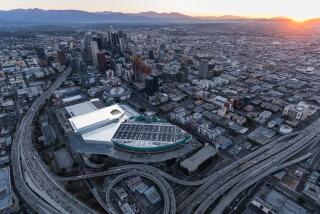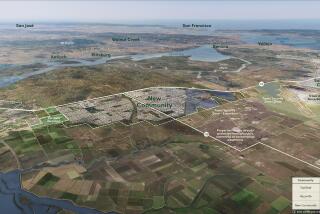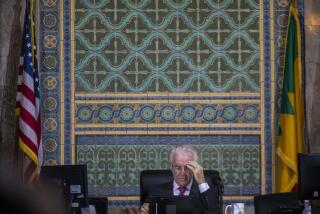Now Advocates Putting on Brakes : Escondido Mayor Does an About-Face on Growth
Escondido Mayor Jim Rady, long identified as perhaps his city’s most prominent pro-development spokesman, made an abrupt about-face Friday, saying it is time for the City Council to put the brakes on growth.
Rady, standing before a breakfast meeting of the Escondido Chamber of Commerce for his state-of-the-city address, called on Escondido’s “mainstream” to embrace a philosophy that some slow-growth advocates in Escondido have championed for years.
But he made it clear that he wants to put distance between himself and the city’s historical slow-growth supporters and, instead, develop a new general plan for city development with input from more established groups such as the Chamber of Commerce.
Councilman Jim Harmon, the most vocal champion of slow-growth policies, later characterized Rady’s speech as “political rhetoric” and said that Rady’s change of heart was “wonderful news, but I’ll believe it when I see it.”
“He is feeling the pressure of what’s happening in the community,” Harmon said, “and it seems to me that he’s just trying to catch up with where the mainstream already is going.”
Rady did not use the speech to trumpet the city’s accomplishments over the past year, as had been expected by the chamber audience, but instead devoted virtually all of it to the issue of growth and the problems it has caused in Escondido.
And he scolded the City Council for not having spent developers’ impact fees to address traffic and other problems created by growth.
“It doesn’t appear that growth is in fact paying its own way,” he said. “The problem is, your City Council isn’t adequately directing the expenditure of those funds.”
He began his talk with a parable about an economist who, when asked about safe investments, advises his client year after year to buy gold. “And every once in a while, he’s right,” Rady said.
“We have had people in this community who have said in the ‘60s, the ‘70s and the ‘80s, ‘stop growth, slow growth, no growth.’ And you know what? Every once in a while, they’re right.
“But only when the mainstream, the responsible portion of the community--you folks, and the majority of your City Council--say maybe it’s time to slow growth, is that going to happen.
“It didn’t happen in the ‘60s because the timing wasn’t right. It didn’t happen in the ‘70s because the timing wasn’t right. But perhaps now we need to re-examine the philosophies of the ‘60s and the ‘70s.”
He said the city has hired a consultant to help update the general plan and another firm to develop a computer model to show the impact new growth would have on schools, streets, parks and other public facilities.
He said the city has deposited development impact fees in the bank instead of spending it to solve growth problems, and the time has now come to start spending that money.
Public improvement projects such as street widening, he said, will cause inconvenience to some people, but “I submit that for the well-being of the entire community, we’re going to have to suffer the short-term pain and the short-term disruptions in order to have a long-term better place to live and raise our children.”
Escondido is currently experiencing a surge of slow-growth activism, with a recent announcement by Planning Commissioner David Barber that he would sponsor a slow-growth initiative in Escondido. And a separate referendum drive now under way is aimed at reversing a recent City Council decision allowing the construction of 256 residential units and an 80-bed convalescent home in a rural part of Escondido previously zoned for half-acre and one-acre residential lots. The referendum organizers were given 30 days to collect about 4,000 petition signatures to qualify for the ballot, a task that Rady had previously said would be “impossible.” But organizers on Friday said they had collected more than 6,000 signatures, with seven days left to collect more.
Alluding to those campaigns, Rady pleaded:
“Don’t overreact to quick-fix initiatives and referenda and petitions. Let’s work together--the mainstream--to acknowledge, to identify and to solve the problems of this community. It can be done.”
Afterward, Rady said he had changed his position on development because “the times, they are a-changing. The economics (of growth) are different now. There are different demands on sewers, streets and the infrastructure that have to be fulfilled.”
The generally unbridled growth to date in Escondido “was needed to finance what (public facilities) we have now. But we weren’t spending those dollars.”
And he said the city’s general plan needs to be amended because “it was drafted in the early ‘60s and we’ve been amending it, piece by piece. Now we need to step back and look at what we’ve been doing.”
Rady said slow-growth efforts by Harmon were unsuccessful because “he can’t get the mainstream support of the community. Jerry Harmon hasn’t accomplished anything in 20 years. He has small groups of people to get him elected, but he can’t affect the community.”
Harmon, who did not attend the breakfast, said later:
“He must be feeling the pressure. It has taken a number of years to cause the problems created by his policies, and finally, now that he sees the community reacting to what I have predicted for 15 years, he is ready to admit that maybe he has made some mistakes.
“It’s difficult, turning around a good-old-boy power structure, but never let it be said that I wasn’t consistent in my efforts, knowing that the inevitable would happen, based on the growth policies the council majority was following,” said Harmon.
More to Read
Sign up for Essential California
The most important California stories and recommendations in your inbox every morning.
You may occasionally receive promotional content from the Los Angeles Times.









